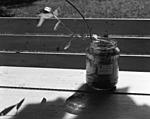Hi,
I had an issue with blown out highlights. I was using ID11 developer at 1: 1 ratio with water , developing for about 11 minutes. Agitating for the first 20 seconds in the first minute and then for 10 seconds every 2 minutes. In trays.
So I decided to do 2 test photos and develop the first one the same way but for 7 minutes and the second one the same way but in a diluted developer of 1 part dev + 3 parts water for 20 mins.
Problem is, I really can't see the difference. Is it possible that this would give the same result? I think the diluted version has more grain.




 Reply With Quote
Reply With Quote



Bookmarks